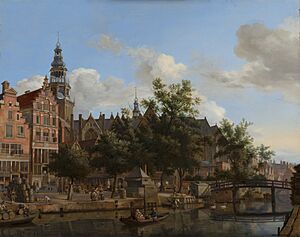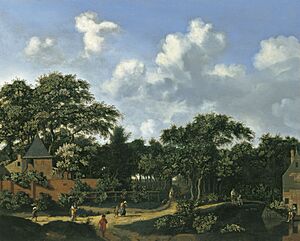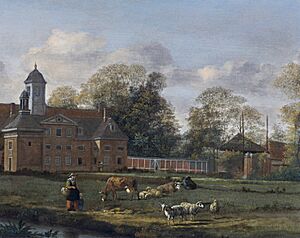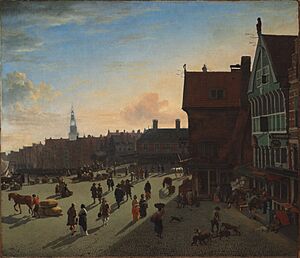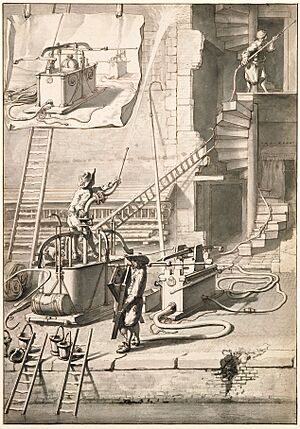Jan van der Heyden facts for kids
Quick facts for kids
Jan van der Heyden
|
|
|---|---|
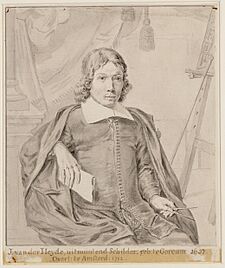
Portrait of Jan van der Heyden
|
|
| Born | March 5, 1637 |
| Died | March 28, 1712 (aged 75) |
| Occupation | Artist, engineer, city official |
| Spouse(s) | Sarah Terhiel |
| Children | Jan, Samuel, Sarah |
| Parent(s) | Jan Goriszoon, Neeltje Jans Munster |
Jan van der Heyden (born March 5, 1637, in Gorinchem; died March 28, 1712, in Amsterdam) was a famous Dutch artist from the Baroque period. He was a talented painter, glass painter, draughtsman, and printmaker.
Jan van der Heyden was one of the first Dutch painters to focus on painting townscapes, which are pictures of cities and towns. He became one of the best architectural painters during the Dutch Golden Age. He also painted some still lifes, which are pictures of objects, at the beginning and end of his career.
Besides being an artist, Jan van der Heyden was also a clever engineer and inventor. He made important improvements to firefighting technology. With his brother Nicolaes, who was an expert in water systems, he invented a better fire hose in 1672. He also improved the manual fire engine and helped reorganize the volunteer fire brigade in 1685. He even wrote and drew pictures for the first firefighting manual!
Van der Heyden also designed a complete street lighting system for Amsterdam. This system worked from 1669 until 1840 and was copied by many other cities.
Contents
Life of Jan van der Heyden
Jan van der Heyden was born in Gorinchem. His father was a mennonite and worked as an oil mill owner, a grain merchant, and a broker. Jan was the third of eight children. In 1646, his family moved to Amsterdam.
Jan van der Heyden probably learned to paint from a relative, maybe his oldest brother, Goris van der Heyden, who made and sold mirrors. He might also have learned drawing from a glass painter. Some of his early paintings on glass still exist today.
In 1661, he married Sara ter Hiel in Amsterdam. At that time, he was already a working artist. His earliest known paintings are from 1663.
When he was young, Jan saw a big fire in the old town hall. This event made a strong impression on him. Later, he would draw or describe about 80 fires that happened in Amsterdam. In 1668, a famous Italian leader, Cosimo III de' Medici, bought one of his paintings.
Painting was not Jan van der Heyden's only job. He was also an engineer, inventor, and city official. He was very interested in finding better ways to fight fires. Between 1668 and 1671, he and his brother Nicolaes spent a lot of time inventing a new and very successful water pumping system.
He also created street lamps and the first street-lighting system for Amsterdam. In 1669, he was put in charge of street lighting for the city.
In 1673, Jan and his brother were officially appointed to manage the city's fire-fighting equipment and organization. These jobs helped the artist become very successful.
In 1680, Jan van der Heyden moved to a new home in Amsterdam. There, he also built a factory to make fire equipment. In 1690, he worked with his oldest son, Jan, to publish an illustrated book about firefighting. It was called 'Beschrijving der nieuwlijks uitgevonden en geoctrojeerde Slangbrandspuiten' (which means 'Description of the recently invented and patented hose fire engines').
Jan van der Heyden died a rich man in 1712. His wife passed away just a month after him. When her belongings were listed, there were more than 70 of his own paintings. His son Jan was his only known student.
Artistic Work
Painting Styles
Jan van der Heyden was one of the first Dutch painters to mostly paint cityscapes and other pictures of buildings. He also painted about 40 pure landscapes, which are pictures of nature. Towards the end of his life, he painted still lifes, which are pictures of objects arranged indoors.
Architectural Paintings
His most common subjects were different views of Amsterdam. He also painted scenes from other Dutch, Belgian, and German cities. He even painted country houses and estates. It is thought that he visited these places himself.
Van der Heyden also created imaginary architectural scenes, called capricci. An example is An Architectural Fantasy (around 1670). This painting seems to be completely made up. It shows Italian influences in its classical buildings, but the people in the painting are clearly Dutch.
Even though his paintings look very realistic and detailed, Jan van der Heyden did not always paint places exactly as they were. He often changed and rearranged buildings and settings to make his pictures look better. His main goal was to create a beautiful and ideal vision of the world. He paid great attention to detail, sometimes even painting every single brick!
Van der Heyden's scenes often have bright, clear light. His skill in using light and shadow, and creating subtle atmospheric effects, makes his paintings feel complete and unified.
The people and animals in his paintings (called staffage) were often added by other artists. He frequently worked with a talented painter named Adriaen van de Velde. They were a great team because van der Velde added lively figures to van der Heyden's beautifully painted buildings. A good example of their teamwork is The Dam and Damrak (around 1663). This painting shows the Dam and Damrak in the late afternoon sun, with long shadows on the cobblestones.
Still Lifes
Jan van der Heyden painted still lifes at the start and end of his career. Nine of his still lifes still exist. One of his earliest still lifes is a Still life with a bible (dated 1664). This painting, and others from his early period, usually show a bible and other objects on a table with a carpet.
An example of his early still lifes is the Still Life with Globe, Books, Sculpture, and Other Objects (around 1670). This painting is part of a long tradition of Dutch still lifes that include "vanitas" symbols. These symbols remind us that life is short and worldly things are not forever. They can include hourglasses, skulls, or candles, but also objects that show learning and knowledge.
The objects in van der Heyden's Still Life with Globe, Books, Sculpture, and Other Objects seem to show two sides of life: the life of thinking and learning (art, philosophy) and the active life (curiosity about the world, trade). The globe and atlas represent exploration and trade, especially with new parts of the world. The Chinese silk cloth, Japanese box, and a South American iguana show imported goods. A map of fortifications from the Eighty Years War also appears, reminding viewers of the nation's history. A Protestant Bible is open to the Proverbs of Solomon, which talks about wisdom and justice.
Van der Heyden stopped painting still lifes around 1670, but returned to them in the last two years of his life. The ideas and objects in his later still lifes were similar to his early ones, but they were painted in a different, more simple style.
His still life masterpiece, Room Corner with Curiosities, was painted in 1712, the year he died, when he was 75 years old. This painting, now in the Museum of Fine Arts in Budapest, also focuses on the idea of "vanitas." The Bible in the front is open to a famous line from Ecclesiastes: 'Vanity of vanities, all is vanity.' This message might have been especially meaningful to the artist as he neared the end of his life. The objects in the painting show different parts of worldly culture, from wealth to intellectual goals.
Museums with Jan van der Heyden's works
- The National Gallery, London, England
- Amsterdams Historisch Museum, Amsterdam, Netherlands
- Rijksmuseum, Amsterdam, Netherlands
- Musée du Louvre, Paris, France
- Mauritshuis, Royal Cabinet of Paintings, The Hague
- Galleria degli Uffizi, Florence, Italy
- National Gallery of Art, Washington, D.C.
- Metropolitan Museum of Art, New York, New York
- Detroit Institute of Arts, Detroit, Michigan
- Museum of Fine Arts, Houston, Houston, Texas
- National Gallery of Armenia, Yerevan, Armenia
- Norton Simon Museum, Pasadena, California
- Yale University Art Gallery, New Haven, Connecticut
Art History and Ownership
In 2019, a painting by van der Heyden called Picture of a Dutch Square was returned to the family of its original Jewish owners, Gottlieb and Mathilde Kraus. The painting had been taken during the time of Nazi persecution. After the war, it was important for the painting to be returned to its rightful owners.


